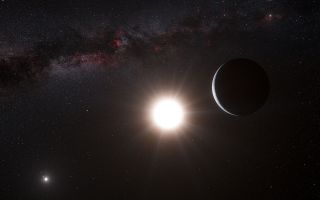Alpha Centauri B Planet Revealed by Telltale Star Wobble

The instrument astronomers used to discover the small rocky planet circling the star Alpha Centauri B that was announced this week was not a glitzy new high-tech space telescope, but rather a decade-old workhorse attached to a ground observatory in Chile.
HARPS, as the instrument is called, successfully detected a rocky planet around one of Earth’s closest neighboring stars when other tools missed it because astronomers have had plenty of time to learn what it is capable of, planet hunter Xavier Dumusque of Geneva Observatory, Switzerland and the Center for Astrophysics at the University of Porto, Portugal, said.
After 10 years of working with HARPS, "we understand much better how the instrument works now," he added.
"And we have used a new strategy to observe the star, which allows us to average the perturbing signals" to eliminate noise.[App Provides Up-Close Look at Far-Out Exoplanets]
Alpha Centauri Bb, as the new planet is known, has a mass about the same as Earth and is likely rocky. However, unlike Earth, it's likely roasting at 2,200 degrees F (1,204 degrees C) due to how close it is to its parent star.
HARPS, a spectrograph on the European Southern Observatory’s 3.6 meter telescope in La Silla, Chile, works by looking for telltale "wobbles" in a star, caused by an orbiting planet gravitationally tugging on the star. That means that it's much easier to find heavy, Jupiter-like planets than tiny low-mass planets.
"This technique depends on two things," Dumusque said. "The mass of the planet — the more mass, the easier it is to detect — and also the distance to the star. In this case, it is a small-mass planet, but it is still very close," which is what made the detection possible.
Get the Space.com Newsletter
Breaking space news, the latest updates on rocket launches, skywatching events and more!
Even still, the researchers had to deal with interfering signals — from the star itself. [Gallery: Nearby Alien Planet Alpha Centauri Bb]

That led to the discovery of the planet, which is "for sure" accompanied by others that scientists haven't yet found, he added. "Statistics show that if you have a very small mass planet in one system, you have other planets in the same system. With this case, with Alpha Centauri B ... we don't have the precision to find them, but for sure there are other planets in the system."
Alpha Cen Bb's gravitational effect on the star causes it to move by just 19.6 inches (50 centimeters) per second. In comparison, if alien observers wanted to discover Earth using the same method, they'd need an instrument that could detect wobbles of 3.9 inches (10 cm) per second. The Espresso instrument, scheduled to go online in 2016, will be able to observe with that precision. "With this instrument, it should be possible to discover Earth's twin," Dumusque said.
Follow TechNewsDaily on Twitter @TechNewsDaily. We're also on Facebook & Google+.

Join our Space Forums to keep talking space on the latest missions, night sky and more! And if you have a news tip, correction or comment, let us know at: community@space.com.

